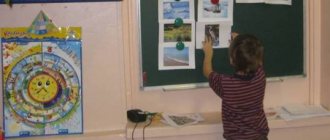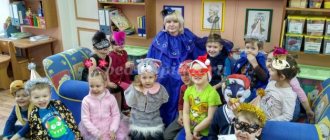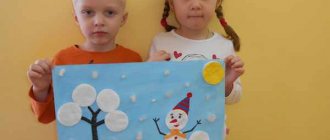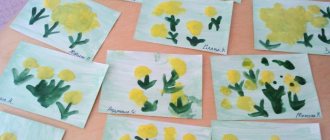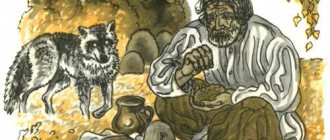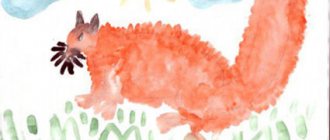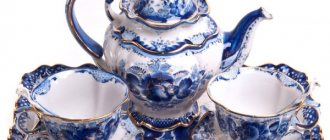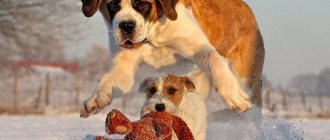ABC School
Objectives: to introduce children to the process of making a book; cultivate a sense of caring for books.
Class progress
- Reading poems. Riddles on the topic.
Teacher.
Guess: Not a bush, but with leaves, Not a shirt, but sewn, Not a person, but a story. (Book.)
– Name your favorite books. The teacher (student) reads a poem.
MY FRIEND
A good book, my companion, my friend, Leisure time can be interesting with you. We are having a great time together, And we are slowly carrying on our conversation...
You tell me about the deeds of daredevils, About evil enemies and funny eccentrics, About the secrets of the Earth and the movements of the planets - There is nothing incomprehensible with you,
You teach to be truthful and valiant, to understand Nature, to understand and love people. I cherish you, I take care of you, I cannot live without a good book.
N. Naydenova
- Teacher's story using illustrations.
All these books were born in a dense forest. At first there was a small pine tree, then it became a pine tree, and as the years passed, the tops of the pine tree reached towards the sun. But one day, lumberjacks came into the forest and cut down this mighty tree. A tractor is in a hurry to help the loggers; in the taiga it is called a forest all-terrain vehicle. Lumberjacks cut off branches, tie them, and tie the trunks tightly with iron ropes - cables. The forest all-terrain vehicle will shudder and puff and pull its heavy load towards the river.
The river is the most spacious road for the forest. Like huge fish, logs are swimming along it downstream. It seems as if the entire river is loaded with forests. Sometimes logs collide, cling to each other, and form jams. And to avoid congestion, raftsmen keep a vigilant eye on the movement of the forest. Strong, brave” skillful people. They swim up to the forest jam in motor boats and use long hooks with sharp tips to push and disperse the interlocking logs. And so the trunks again continue their path along the deep, wide road. The blue road will lead the trunks to the plant. They will be used to make paper. Here the trunks move from workshop to workshop. The trees there are sawed and ground into sawdust. Next, it is boiled to obtain a fibrous mass similar to batter. The machines pour and roll out the paper dough, then the strips are turned into paper. An endless ribbon of paper crawls out of the machine and is wound into huge paper rolls.
- How can you make a book out of rolls?
- I need to write a book. Who will write the book?
Writers need to know a lot to write an interesting book. And to make the book very colorful, more work needs to be done by professionals.
-To whom?
Long ago, in the old days, books were written by hand. It was rare and highly valued. Then people thought: “After all, many people want to read the book. How can I help propagate a book?”
Now the book is not copied by hand, but printed in a printing house. Do you have textbooks? They are all the same. They were made in a printing house.
Printing house - book factory. Like any factory, there are many workshops here. In one workshop they prepare paper, in another - paints, and in each workshop - machines. Now books are made using machines. Blank white paper goes into the printing machine and comes out with text and pictures. Next, you need to fold the sheets into a notebook - fold them, as they say in the printing house, select them correctly, the pages should go one after another. The book still has a long way to go until it reaches the machine that makes the cover for it.
Then the books end up in a bookstore or library.
This is how long a book goes to turn from wood into a book. This is a lot of work by people, and we must respect this work and take care of the book.
- Dramatization of a fable*.
TWO BOOKS
One day two books met and talked to each other. - Well, how are you doing? -One asked the other.
- Oh, honey, I’m ashamed in front of the class, My owner tore out the covers with meat! What about the covers... I tore off the pages! He makes boats and rafts from them
And doves... I'm afraid the leaves will become snakes, Then I'll fly into the clouds! Are your sides intact?
- Your torment is not familiar to me, I don’t remember such a day, So that, without washing your hands clean, a student sat down to read me! And look at my pieces of paper, You won’t see any inky dots on them.
I’m silent about the blots, - It’s indecent to even talk about them... But I teach him too, Not just any way, but “excellent”.
- Well, mine barely rides in grades and even got a grade that week... There is no riddle in the fable: books and notebooks will tell you straight out what kind of student you are.
Summary of GCD in the senior group. Where did the book come from?
Summary of educational activities for children 5-6 years old.
Topic: “Where did the book come from?” Main activity. Cognitive - research activities. Form of activity. Joint activities of adults and children. Form of conduct. Presentation and conversation. Target. Development of children's cognitive interest and interest in books. Integration of content of educational areas. Cognition. Continue to enrich children's understanding of the world of objects. To form the idea of children that any thing was created by the labor of an adult. Cultivate a caring attitude towards books - a source of knowledge and wisdom. Work. Continue to expand children's understanding of adult work. To provide knowledge about the work of printing workers. Cultivate respect for people, creators of books. Communication. Develop the ability to maintain a conversation. Exercise children in selecting adjectives for nouns, forming verbs from nouns. Help children use words exactly as they mean. Preliminary work. Game situation “Exhibition of books - such different books.” Materials for the lesson. Box with wooden objects and a book inside, books, presentation "The story told by the book." Progress of activities. 1. Motivation for activity. All the children gathered in a circle. I am your friend and you are my friend. Let's hold hands together and smile at each other. — Children, they gave me a set of objects. It says here, made of wood. Let's see what lies inside? Children look at the objects in the box. Game "Which, which, which, which" spoon, which? (wooden) soldier, which one? (wooden) nesting doll, what kind? (wooden) egg, which one? (wooden) cubes, what kind? (wooden) - How did the book end up among these objects? (Children's assumptions) The teacher takes the book in his hands and brings it to his ear. — Children, the book told me an amazing story. It turns out that she came to us from the forest and was made of wood. More precisely, not a book, but the paper from which the book is made. Do you want me to tell you this story? 2. Presentation “The story told by the book.” - I was born in the forest. Lumberjacks cut down the trees and took them out of the forest. The trees were brought to a paper mill, stripped of bark, sawn, and ground into sawdust. The sawdust was boiled to form a batter-like mass. The wood dough is rolled out into long, wide strips. The raw paper strip passes through a series of rollers. Some rollers squeeze out the water, others dry the tape, and others polish it. An endless ribbon of paper crawls out of the machine and rolls into huge paper rolls. Then the paper is cut by a special machine into sheets of the required size. Thus, moving from machine to machine, wood turns into paper. Paper was made at a paper mill. But this is not enough for a book to appear. - Who will help turn white paper into a magic book? (children's answers) - Who will come up with interesting stories and fairy tales, write poetry? (children's answers) - What writers and poets do you know? (children's answers) - Who will draw beautiful pictures in books? (children's answers) - What illustrators do you know? (children's answers) - So, the magical transformation of white paper into a book begins. The writer writes a manuscript. A manuscript is something written by a person's hand. The writer brings his manuscript to the editor. The editor reads the book carefully and edits it. Editing means correcting the manuscript and correcting errors. The editor hands the book to the artist. The artist reads the manuscript and draws pictures to accompany the text - illustrates. — What fairy tale does Evgeniy Mikhailovich Rachev draw an illustration for? (children's answers) - The writer wrote a story or fairy tale. The artist illustrated the book. But this is only one book. And there are a lot of children in our country, and they all dream of reading this book. How to be? (children's answers) - There is such an amazing place - a printing house. Books, magazines, and newspapers are printed here. First, the book is prepared for printing. The editor edits, the artist illustrates, the proofreader corrects the text, the designer thinks through the design of the book. The typesetter and printer create a book layout (sample). When the book layout is ready, you can replicate it and print it. In Russia, children's books are published in large quantities. — They print in a printing house on large sheets, several pages at once. You’ve printed it, but it’s inconvenient to read, what should you do? The sheets of the future book are folded on a special machine and collected into one book. But is something missing? Need a cover and binding! Various complex machines help printing workers print books. - Now you and I will rest a little. Imagine that you are in the forest. There is fresh, pleasant air in the forest. Inhale it deeply, exhale deeply and slowly. (Breathing exercise 3-4 times) Physical education You and I are entering the forest, There are so many miracles around here! They raised their hands and shook them, These are trees in the forest. The arms are bent, the hands are shaken. The wind knocks down the dew. Let's wave our hands to the sides, smoothly - These are the birds flying towards us. Let's show how they land smoothly - the wings are folded back. They bent over and sat down. Together they flew into their nests. Children take books and look at them. — To prevent the sheets in the book from getting mixed up, the page number is written on the sheets of paper (showing the page numbering in the book). The folded sheets are stitched, glued or fastened with scrapers. In your book, how are the leaves connected? (children's answers) - The cover of a book can be soft or hard (made of cardboard) (showing book covers). If the book is thick, the covers are connected by a binding (showing the binding). Game "Add a Word". - Add words in rhyme and meaning. There is a little book of clothes, It’s called -.... (cover). There are books in the garden and at home. Made of paper and... (cardboard). Our books are not simple, in order they are... (sheets), So as not to get lost when reading, Numbered.... (pages) . The pages are all crossed, They are held together.... (binding). — On the cover of the book they write the name of the author and the title of the book (show). Sometimes the artist's last name is written. And at the end of the book, (show) the printing house in which this book was printed and the names of some people who helped print this book must be indicated. Unfortunately, it is impossible to write in the book the names of all the printing house workers who participated in the creation of this book. Why do you think? (children's answers) - That's right, a lot of people work on creating one small book. If you print all the names, the book will be very thick and heavy, and children will not be able to lift it. — You and I will remember those who created our books. Game "Who does what." Writer (writes, composes) Illustrator (illustrates, draws) Editor (edits) Proofreader (corrects) Typesetter (types text) Printer (prints a book) - When all the children go home, the group becomes quiet and quiet. One day I heard what the books were whispering about. Do you want to know what the books whispered about? Please don’t pick me up with dirty hands, I’ll be ashamed if I’m dirty or stained! — one book whispered, “Don’t bend my binding.” I may lose the most interesting pages! - said another book. Please use a bookmark and do not fold my pages, they will tear! I love cleanliness, but I'm afraid of water. Protect me from rain and snow! Please do not draw on my pages with pen or pencil. It will be difficult for other children to read me! — Do you remember the requests of the books? Try to fulfill them! - This is what people say about books. A good book is your best friend. Gold comes from the earth, and knowledge comes from books. You read a book and fly on the wings of a dream. Illiterate is like a blind man, but a book opens his eyes. The book will help in work, and will help out in trouble. 3. The result of the activity. — What new or interesting things did you learn today? (children's answers) - What else would you like to know? (children's answers) - Who will help us find new knowledge? (children's answers) - Thank you, it was a pleasure talking with you. Autotraining. And now we will smile, Let's hold hands together.
And as a farewell we will give each other a wish - Always seek knowledge. Then you will become smart! Presentation on the topic: The story told by the book
We recommend watching:
Game - quiz on traffic rules in the senior group “Young Pedestrian” Summary of GCD in the senior group. A journey through Chukovsky's fairy tales Synopsis of direct educational activities in the senior group for children with mental retardation Synopsis of cognitive and research activities in the senior group
Similar articles:
Summary of a safety lesson in the senior group: Safety in nature
Lesson on basic safety in the senior group. Topic: Rules of conduct while walking
Life safety tasks for children 5-7 years old
Summary of educational activities in the senior speech therapy group on the topic “Construction”
Summary of GCD in the senior group on the topic “Little Townspeople”
Employees of the “Childhood” department offer readers a virtual exhibition “How did the book appear?”, dedicated to the history of the emergence of writing and books.
Scientists believe that the history of the birth of the book began with the advent of writing, when primitive hunters made their drawings and inscriptions on the stone walls of ancient caves. As millennia passed, people used a variety of materials, tools and signs to record their thoughts. For example, in India in ancient times they wrote with a needle on palm leaves, in Mesopotamia more than five thousand years ago they covered small clay tablets with cuneiform. The ancient Egyptians wrote on papyrus using complex characters called hieroglyphs. The alphabet, consisting of letters, was used by the ancient Greeks. They also invented wax books: special square-shaped tablets were filled with wax. They wrote on such “pages” with the sharp end of a stick. Residents of ancient Russian cities used small pieces of birch bark for household and economic records. But books in Rus', as in Europe, were made from parchment - finely dressed animal skin. Parchment books were the predecessors of paper books.
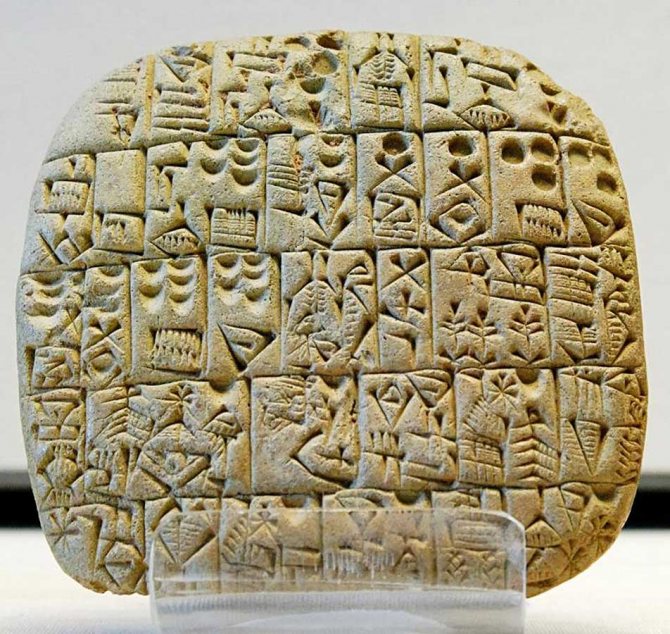
The form of books was also varied. For example, in ancient China, when they wrote on bamboo tablets, transporting even one book could require several carts. The ancient Chinese books made of silk that appeared later, like the ancient Egyptian ones made of papyrus, were made in the form of a scroll. But the parchment books looked like a chest, and each one was locked with a padlock.
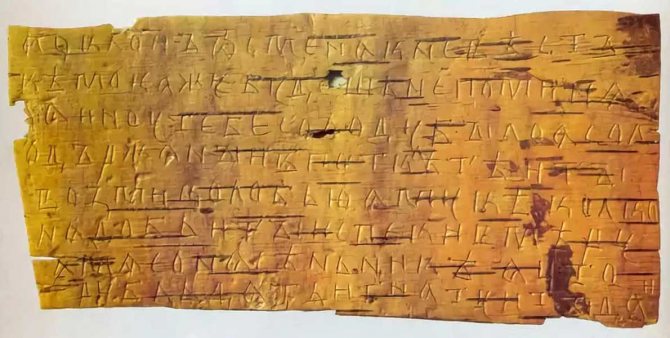
At a time when there were no printing presses, every book was written and rewritten by hand. Therefore, books were very expensive, and only rich people could buy them. This was the case until the European master Johannes Gutenberg invented the printing press in the 15th century. In Russia, the first printing presses appeared under Tsar Ivan the Terrible. The founder of book printing in Rus' was Ivan Fedorov, and the first printed book, “The Apostle,” was published in 1564. Over the next few centuries, printing developed and improved, and from the 19th century, books became available to everyone.
In our time, the history of the book has received a new development. Nowadays computer technology is used to create books. There are also e-books. And with the help of the Internet you can easily and quickly gain access to the rarest and most valuable publications.
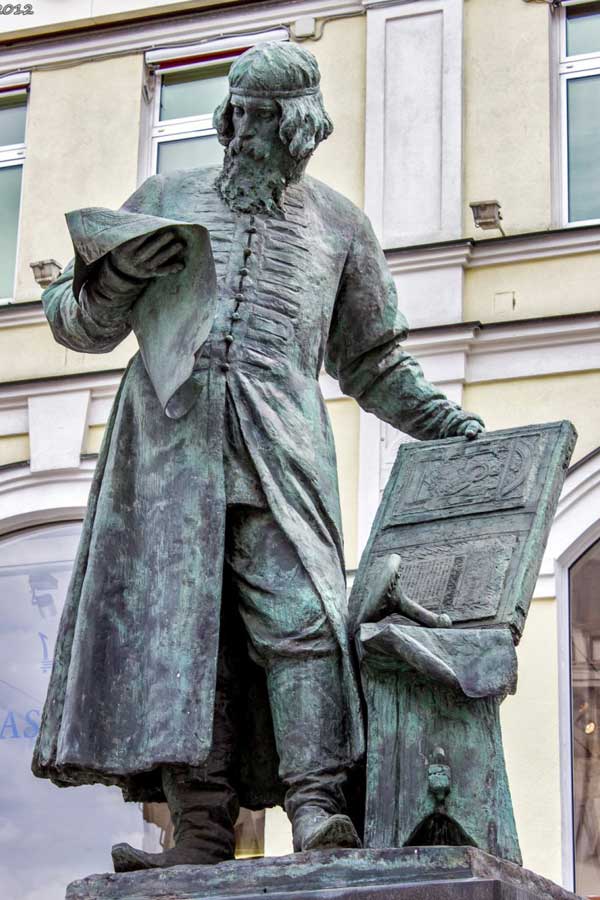
The book exhibition offered to the attention of readers is made up of popular science and fiction literature, which is addressed to children of senior preschool, primary and secondary school age, but will also be of interest to parents and teachers. The exhibition is presented in two sections.
The publications collected in the first section will not only thoroughly acquaint children with the history of books and writing, provide many interesting details, but also tell about modern publishing and library science. Children will learn how a printing house works, what role writers, illustrators, and publishers play in creating books, and how a library works. Smart and beautiful books will teach their readers interesting games with letters and signs, and will reveal the secrets of making unusual homemade books.
The second section presents books from the recent past of printing. Readers can get acquainted with the publications of the late 19th – first half of the 20th centuries, each of which has its own interesting feature. Especially for the exhibition, they were kindly provided by employees of the retro fund of the “Reading Room” sector of the “Adolescence” department. Youth".
Bibliography
Popular science literature
- Valkova, V.G. Knizhkin House / Valentina Grigorievna Valkova, Alexandra Nikolaevna Bedroom. Moscow: Book Chamber, 1990. – 80 p.
- Datskevich, V.P. How a book is made / Viktor Petrovich Datskevich. – Moscow: Children’s literature, 1987. – 25 p.
- Malov, V.I. Book. Children's Encyclopedia / Vladimir Igorevich Malov. – Moscow: Slovo, 2002. – 48 p. : ill.
- Nemirovsky, E.L. Journey to the origins of Russian book printing / Evgeniy Lvovich Nemirovsky. – Moscow: Education, 1991. – 224 p. : ill.
- Osetrov, E.I. The Tale of Drukar Ivan and his books / Evgeniy Ivanovich Osetrov. – Moscow: Malysh, 1979. – 95 p. : ill.
- Pavlov, I.P. About your book / Ivan Prokofievich Pavlov. – St. Petersburg: Children’s literature, 1991. – 113 p. : ill.
- Perehvalskaya, E.V. Where did the alphabet come from / Elena Vsevolodovna Perekhvalskaya. – Moscow: Malysh, 1989. – 25 p. : ill.
- Prudovskaya, S.N. The history of letters with your own hands / Svetlana Nikolaevna Prudovskaya. – Moscow: Compass Guide, 2013. – 84 p. : ill.
- Prudovskaya, S.N. The history of the book with your own hands / Svetlana Nikolaevna Prudovskaya. – 2nd ed., Spanish. – Moscow: Compass Guide, 2012. – 60 p. : ill. – (Do-It-Yourself Books Series).
- Prudovskaya, S.N. The history of the book with your own hands. Continuation / Svetlana Nikolaevna Prudovskaya. – Moscow: Compass Guide, 2014. – 84 p. : ill.
- Acceleration, L.E. Black and white / Lev Emmanuilovich Acceleration. – Moscow: Malysh, 1982. – 30 p. : ill.
Fiction
- Barkov, A.S. Where did the book come from / Alexander Sergeevich Barkov, Ruben Vasilyevich Suryaninov. – Moscow: Malysh, 1974. – 12 p. : ill.
- Be a hero: stories and poems / rep. ed. Leon Cohn. – Moscow: Children’s literature, 1941. – 62 p.
- Zubkov, B.V. A book about a book / Boris Vasilievich Zubkov. – Moscow: Malysh, 1984. – 24 p. : ill.
- Marshak, S.Ya. How your book was published: poem / Samuil Yakovlevich Marshak. – Moscow: Detgiz, 1951. – 8 p. : ill.
- Nekrasov, N.A. Poems for children / Nikolai Alekseevich Nekrasov. – Ivanovo: State Publishing House of the Ivanovo Region, 1937. – 50 p. : ill.
- Pushkin, A.S. The Captain's Daughter: a story / Alexander Sergeevich Pushkin. – Moscow: Children’s literature, 1934. – 128 p.
- Pushkin, A.S. Ruslan and Lyudmila: poem / Alexander Sergeevich Pushkin. – Moscow: Publishing house A.I. Mamontova, 1899. – 47 p. : ill.
- Pushkin, A.S. Fairy tales / Alexander Sergeevich Pushkin. – Germany: Reader Digest Publishing House, 2002. – 223 p. : ill.
- The Tale of Ivan Tsarevich, the Firebird and the Gray Wolf: Russian folk tale. – St. Petersburg: Publication of the expedition for the procurement of state papers, 1901. – 12 p. : ill.
